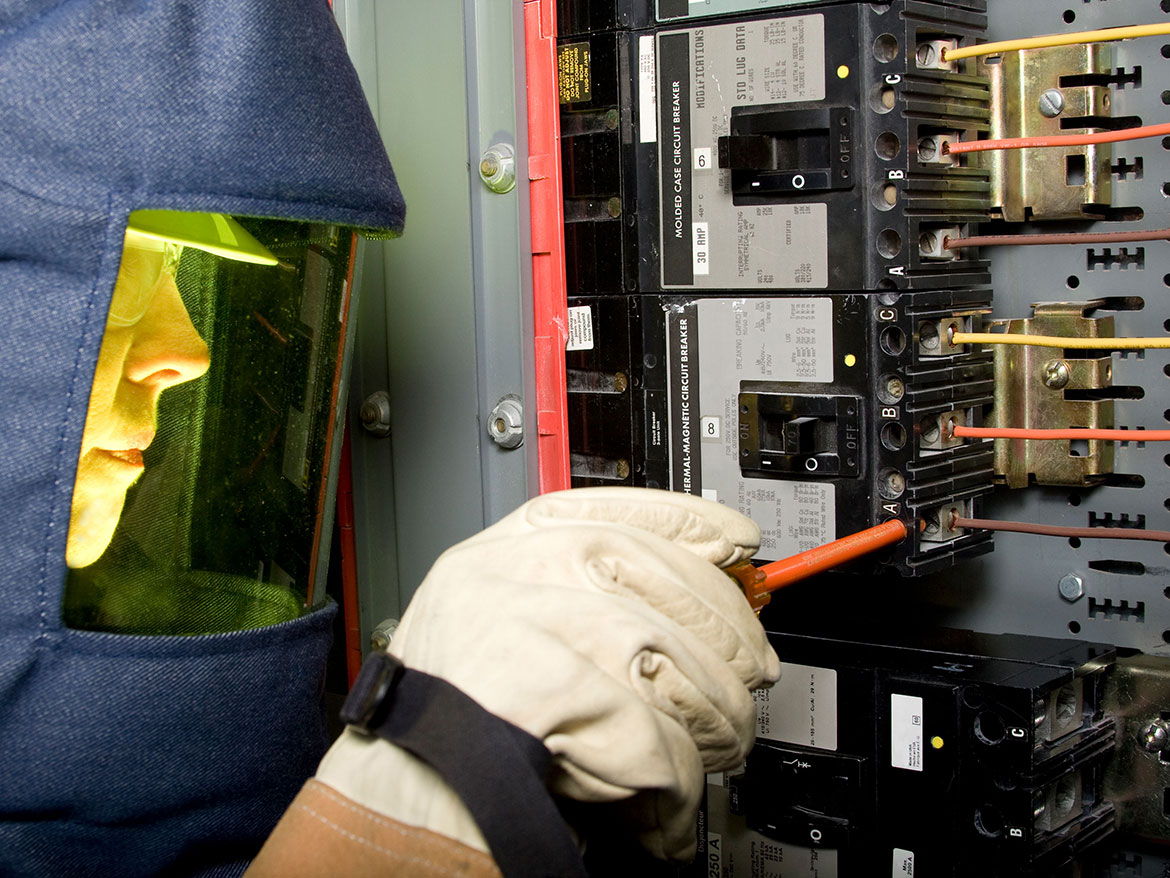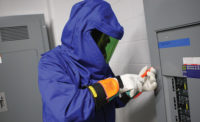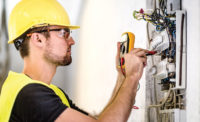NFPA 70E® training protects employees from electrical hazards in the workplace. Training is required for both “qualified persons” and “non-qualified persons.” However, many facility managers and line supervisors are uncertain or confused by these definitions.
A “qualified person” as defined in 70E® is a person who demonstrates necessary skills and knowledge relating to the construction and operation of electrical equipment and installations. Qualified persons are trained to identify hazards and mitigate associated risk. Overhead power lines, damaged tools and equipment, inadequate wiring and overloaded circuits, exposed electrical parts, improper grounding (the most common OSHA electrical violation), damaged insulation and wet conditions are the most common electrical hazards in a work environment.
NFPA 70E® training requirements for qualified persons include using precautionary techniques for working around hazards; proper use of personal protective equipment (PPE); proper use of insulating tools and test equipment; determining nominal voltage; distinguishing exposed, energized conductors and circuits from other parts of equipment; understanding the approach distances and determining factors that shape the distance of shock and arc flash boundaries; being able to plan jobs safely; identify electrical hazards; assess associated risk, and select appropriate risk controls.
Unqualified persons
Unqualified persons also need to be trained, according to NFPA 70E® requirements. These workers must be able to execute any electrically-related safety practices necessary to protect them from electrical hazards. These employees do not do the diagnostic electrical work of a qualified person but may encounter electrical equipment as part of their job. Employees using extension cords and portable electrical equipment are non-qualified workers. A janitor opening a panel to turn on or off lights in a facility is considered non-qualified, as is an operator who starts equipment and performs work on it as his/her daily tasks.
Unqualified persons do not encounter the degree of risk as qualified individuals, but employees may be qualified for some tasks and unqualified for others. One approach to designate qualified from non-qualified workers is to provide training in basic electrical safety concepts and assess an individual’s training performance at the end of the course by assigning a score. Based on the score, the individual may possess the knowledge and skills necessary to take a qualified course to become a qualified person. Lower assessments and scores may indicate more basic training is needed before an individual steps up to the qualified courses.
Targeting training for qualified persons to the level required is a challenging aspect of NFPA 70E® training. Qualified individuals can perform very different kinds of work in the same facility. One person may be qualified to work with heavy equipment. Another may be qualified to perform only maintenance. Others might be qualified for troubleshooting.
Supervisors
NFPA 70E® also calls for supervisors, including safety and health professionals if they are on site, to be trained. They must have sufficient oversight knowledge of electrical hazards and 70E® requirements to monitor practices of qualified and unqualified personnel involving electrical dangers.
A common question in facility management is, “Well, Lyle has been troubleshooting for 30 years. We send him all over the plant. But is he qualified to do this? Lyle has taken qualified training for some tasks, but how do we know if he’s qualified for troubleshooting?”
This is where a third-party, objective and knowledgeable in 70E® requirements, can help make these judgments and provide training.
Outsourced training may also be called in facilities with sophisticated safety and health programs. Best-in-class organizations with robust safety and health management systems and credentialed occupational safety and health specialists on staff know their training needs, but may lack training capacity. This is especially true in growing industries. New hire safety orientation training for e-retailers and express delivery services, for example, can overwhelm internal training departments due to constant hiring.
Risk considerations
All employees exposed to unsafe levels of electrical hazards should receive training for 70E® to understand the hazards of an energized electrical system and provide a basic foundation for safe energized work practices. The type and extent of training depends is determined by the risk to the employee. Outside contractors and others who may visit the facility should also be considered.
NFPA 70E Article 110.2(A) states:
“The training requirements contained in this section shall apply to employees exposed to an electrical hazard when the risk associated with that hazard is not reduced to a safe level by the applicable electrical installation requirements.”
Outside training providers can also modernize training systems. A family-owned manufacturing facility may outgrow what was once sufficient “old school” safety training, relying on the experience of a veteran of 30 years to show new hires how to stay out of harm’s way.
Hands-on training
NFPA 70E® training differs from your typical OSHA compliance training. It requires technical, hands-on training for employees (beyond supervisory oversight training). Procedures and practices are typically learned by doing the work. This is not “sit back and listen” to a lecture on hazard communication. And 70E® training often needs to be customized to an employer’s assets — panels and equipment — as well as the PPE and terminology used by the employer. Employers with powerful energized assets and high-risk hazards sometimes want training at a higher level than required by 70E®.
70E® training is also different than other safety training because retraining is required every three years as NFPA 70E® is updated. The 2021 edition of 70E® is now in effect, and outside providers have refreshed retraining based on the 2021 edition requirements. Retraining or additional training in 70E® is also necessary if an employee receives a job transfer or is promoted to a new position, additional training is required.
Human performance
The 2018 edition NFPA 70E® for the first time focused on human performance and human error knowledge and skills. Very few safety training courses take on human factors and human error. One requirement, a human performance strategy, is to hold pre-job briefings before a shift’s work begins. Workers gather briefly to review hazards and ensure the right person is doing the right job. This “huddle” is a form of risk assessment that goes beyond electrical hazards to cover all risk associated with the work, procedures to be used, any special precautions, control of energy sources, and required PPE. NFPA 70E® contains an example of a “Job Briefing and Planning Checklist.”
Employers can use NFPA 70E’s® emphasis on risk assessment to train on hazards including work at height, slips and falls, confined space entry; human error; and human performance factors such as fatigue and complacency. Risk assessment training is typically not presented to all employees but is seen as the expertise of occupational safety and health professionals.
NFPA 70E® training will increasingly make use of technology tools in today’s virtual world. In 2021 due to COVID-19, in-house and outside third-party training is almost exclusively presented in a virtual, interactive platform that streams live video of the instructor to participants and mixes in live polling, real-time results, gamification, chat boxes. Technology tools such as wearable cameras connecting on-site workers with remote learners to identify hazards, conduct risk assessments, and mitigate risks is creating virtual, hands-on training that is in the early stages of development and will grow as it becomes more accepted (as pilot projects prove efficiency), more scalable (accessible) and more customizable.



